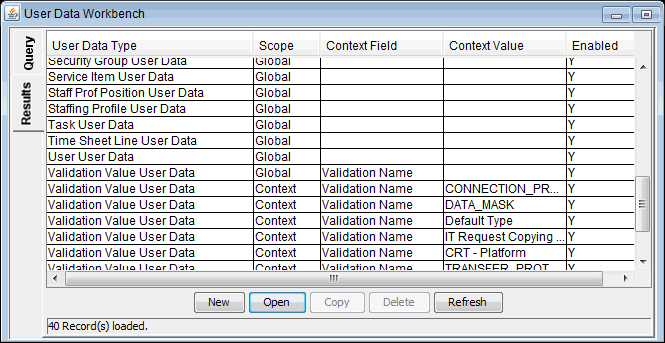Overview of user data
This topic provides information about user data.
User data components
Product entities such as packages, workflows, requests, and projects include a set of standard fields that provide information about the entities. While these fields are normally sufficient for day-to-day processing, you can create user data fields to capture additional information specific to your organization. For example, if you want to include an additional field on every package, you can open the Validation Value User Data user data type (with global scope) and define the extra field, which is then displayed on the User Data tab for a validation.
You configure user data types from the User Data Context window in the User Data Workbench. In Figure 10-1. User data types, the User Data Workbench Results tab lists some of the preconfigured user data types available.

The following columns in the User Data Workbench define the components that fully define a user data type:
-
User Data Type. This column displays the user data type names, which are predefined and uneditable in PPM.
Although you cannot create new user data types, you can create new user data contexts (based on the Validation Value User Data, the Package User Data, or the Environment User Data types) and define user data fields for them.
-
Scope. This column displays the scope of the user data type field. The two possible scope values are:
-
Global. If the user data type field has a global scope, the User Data tab for every designated entity contains the defined user data field.
-
Context. If the user data type field has a context scope, then the defined user data field is added only to the User Data tab for entities that have specific Context Field and Context Value definitions.
-
-
Context Field. This column displays the context-sensitive fields. It applies only to user data type fields with context scope. Because each user data type only has one available context field value, the cells in this column are populated automatically.
-
Context Value. This column lists the value (context) for the context-sensitive field. It applies only to user data type fields with a context scope. You cannot create a new context value. You can only assign an existing one.
You can define up to 20 user data type fields for display on the User Data tab of a defined entity. You can configure the major attributes of each field, including its graphical presentation, the validation method, and whether it is required.
Reference user data
Once you have defined a user data field, you can refer to it from other parts of the product (in notifications and command executions) by using its token name, preceded by the entity abbreviation and the user data (UD) qualifier. For example, Validation Value User Data might have the field "Class Name" with the token value CLASS_NAME, and the user data qualifier USER_DATA1.
Migrate user data
For any configuration entity that has user data type fields, the data in the user data type fields is migrated with the entity.
-
If two instances have identical user data configurations, then the user data is migrated correctly.
-
If two instances do not have identical user data configurations, then the user data is mapped to the data model according to the storage configuration in the source instance. Verify that the two instances have the same user data fields. Otherwise, you must correct the user data after migration.
-
If the user data is context-sensitive, then a corresponding context-sensitive configuration must exist in the destination instance, or the migration fails.
-
User data fields that have hidden and visible values can cause problems. If the hidden value of a user data field refers to a primary key (such as Security Group ID) that is different in the source and destination instances, the migrator does not correct the hidden value. In this case, you must correct the user data manually, after migration.
 Next steps:
Next steps:










